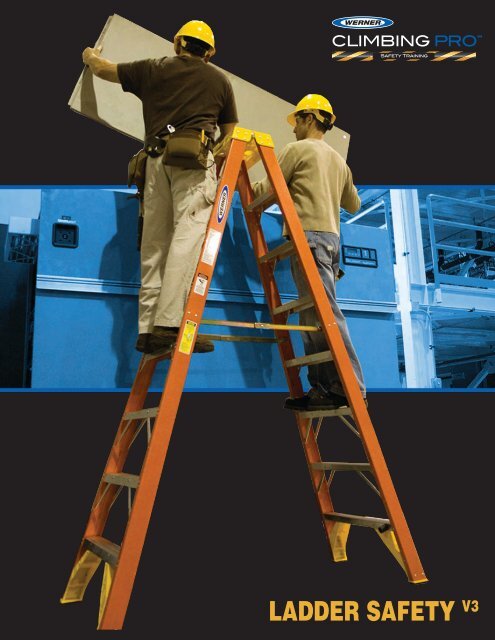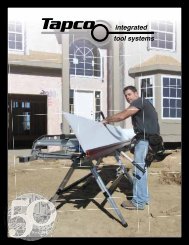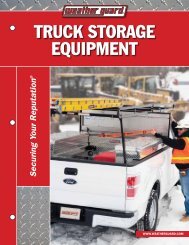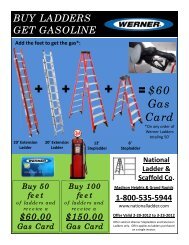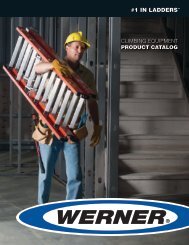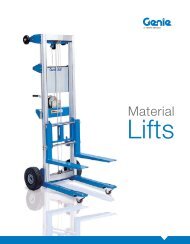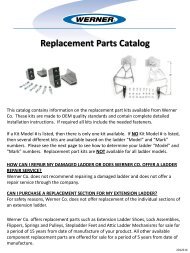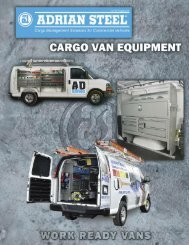LADDER SAFETY V3 - National Ladder and Scaffold Co.
LADDER SAFETY V3 - National Ladder and Scaffold Co.
LADDER SAFETY V3 - National Ladder and Scaffold Co.
Create successful ePaper yourself
Turn your PDF publications into a flip-book with our unique Google optimized e-Paper software.
<strong>LADDER</strong> <strong>SAFETY</strong> <strong>V3</strong>
What’s new with <strong>LADDER</strong> <strong>SAFETY</strong> <strong>V3</strong> ?Includes Utility <strong>Ladder</strong>accessoriesImproved <strong>Ladder</strong>Safety Do’s & Don’tsIncludes Twin Stepladders<strong>and</strong> Platform <strong>Ladder</strong>sImproved <strong>Ladder</strong>InspectionThe Werner Climbing PRO SM Training Program is not intended to be a complete ladder safety training program. It is designed toprovide a general overview of basic Werner ladder safety through ladder selection <strong>and</strong> illustrated safety tips.Numerous federal, state, local, OSHA <strong>and</strong> industry regulations apply to ladders. It is your responsibility to be aware of <strong>and</strong> tocomply with these rules <strong>and</strong> regulations. OSHA regulations m<strong>and</strong>ate that employers provide training regarding the proper useof ladders. For further information, contact your local OSHA office.
FACILITATOR’S GUIDERecommended Training Program StructureI Advance PreparationThis ladder training consists of:1. <strong>LADDER</strong> <strong>SAFETY</strong> <strong>V3</strong> training manual (1 copy)2. <strong>LADDER</strong> <strong>SAFETY</strong> <strong>V3</strong> training DVD (English & Spanish) (1 copy)3. Written quiz (1 copy)3. <strong>Ladder</strong> Safety Tips brochure (25 copies)4. Downloadable literature CD (English & Spanish) (1 copy)Prior to conducting your first training session, please review the DVD <strong>and</strong> thoroughly study the training manual. As you viewthe DVD <strong>and</strong> read the manual, think about the questions that might arise.Werner products, if available should be taken from customer’s existing inventory for demonstration purposes:1. Stepladder (1)2. Extension ladder (1)3. Fiberglass tripod ladder (1)4. Twin Stepladder (1)5. Platform Stepladder (1)II <strong>Co</strong>nducting the Training <strong>Co</strong>urseA. Introduce the program by reviewing the benefits, then discuss the two leading causes of ladder related injuries: (5 minutes)a. Using the wrong ladder for the jobb. Misusing or abusing climbing equipmentThis program has been established into sections:a. “How To Choose” the right ladder for the jobb. “How to Use” ladders safelyWe suggest that you do not pass out the ladder safety tips brochure until you have shown the DVD. This way, people will focus onthe training program <strong>and</strong> not be distracted by the printed material.B. Play the DVD (Approximately 20 minutes)C “How To Choose” the right ladderi. Style1. Determine if a stepladder, extension ladder or special application ladder is required2. Review the various designs available <strong>and</strong> where they can be used:EXAMPLE:1. Twin stepladders are used when two people need to work together on the same job2. Fiberglass tripod ladders are used to work in tight areas, around corners, through studs <strong>and</strong> uneven groundii. Select Height (Size)1. Choose the right stepladder, extension ladder or specialty ladder height2. Discuss the highest st<strong>and</strong>ing level or length3. Refer to chart located on page 82
FACILITATOR’S GUIDEII <strong>Co</strong>nducting the Training <strong>Co</strong>urse (continued)iii. Select Performance (Duty Rating)1. Review the different duty ratings <strong>and</strong> what they meana. Duty rating is the total weight the ladder is designed to support (Total weight is the sum of a person’s weight plus theweight of any tools, clothing <strong>and</strong> materials.); this total weight must not exceed the duty rating.iv. Select Material1. Discuss the various materials used in the fabrication of ladders <strong>and</strong> their unique advantagesa. Fiberglass:i. 7-layer constructionii. For use around electricityiii. Durable <strong>and</strong> corrosion resistantiv. Pro-preferredb. Aluminumi. Lightweightii. Not for use around electricityiii. Durable <strong>and</strong> <strong>Co</strong>rrosion resistantD. Review safety tips brochure (Approximately 15-20 minutes)a. Reading instruction labelsi. Discuss general information on labelsb. <strong>Ladder</strong> Inspectioni. Procedure for examining a ladder prior to climbingii. Know the various components of the ladderc. Care <strong>and</strong> Maintenancei. Plan <strong>and</strong> implement regular maintenance programii. Keep ladder cleaniii. Replace worn or damaged parts or ladders; “If in doubt, tag it out of service.”iv. Important: Discuss the availability of replacements parts. Only Werner replacements parts should be used onWerner ladders.d. Safety Before you Climbi. General review of each bullet point in brochuree. Safe Climbing Habits - Right Wayi. General review of each bullet point in brochuref. Safe Climbing Habits - Wrong Wayi. General review of each bullet point in brochure3
Welcome to the Werner ClimbingPRO SM Training ProgramThis program is about ladder safety. The two principal causes of ladder related injuries are using the wrong ladder for thejob <strong>and</strong> misusing or abusing climbing equipment.Our goals are very simple: We want to help you better underst<strong>and</strong> how to choose the right ladder for the job <strong>and</strong> learnhow to use ladders more safely. The first part of the program reviews the four key elements of ladder selection. Thesecond part contains illustrated ladder use safety guidelines.Smart <strong>Ladder</strong> Users are Safe Climbers<strong>Ladder</strong>s are such common everyday tools that many workers take themfor granted. As you read the safety guidelines, you may say: “I knowthat, that’s just plain common sense.” You can avoid a ladder injury,if you think before you act, <strong>and</strong> use ladders correctly. Your work will beeasier <strong>and</strong> more productive too. <strong>Ladder</strong> related injuries arepreventable, but it takes “you” to prevent them.If you have product or safety questions, please ask your Werner<strong>Ladder</strong> Distributor or call the Werner Customer ServiceDepartment at 1-888-523-3371 for assistance.4
HOW TO CHOOSEKnow the DifferenceSome workers might not realize the differences from one ladder to the next <strong>and</strong> they think. . . a ladder is a ladder. . . WRONG!Having the right ladder for the job is the safest way to complete any task. Using the wrong ladder is extremely dangerous, as itoften leads to ladder misuse or abuse, <strong>and</strong> can result in serious injury or even death. To get an idea of some of the different waysthat ladders are used, just think about all of the tasks you <strong>and</strong> other professionals do. Most of them require the use of ladders ofdifferent styles, sizes, duty ratings <strong>and</strong> materials.Some of the questions that may help you to underst<strong>and</strong> your needs include:1. Where will the ladder be used? Indoors, outdoors or both?2. Will you want to work together with another person on the ladder?3. What is the highest height you wish to reach?• Will the ladder also be used to reach other heights?• What obstacles might be in the way?4. What activities will the ladder be used for? What tasks will you be performing?5. How much weight will be on the ladder, including your tools <strong>and</strong> materials?6. Is there even a remote possibility of contact with electricity or overhead power lines?The Werner ClimbingPRO SM Training Program will review the four key elements you should consider in selecting a ladder:1. STYLE Which kind of ladder is right for the job?2. SIZE How high do you need to reach?What size ladder to buy?3. DUTY RATING How much weight will be on the ladder?4. MATERIAL Where will the ladder be used?Will you be working near electricity?5
<strong>LADDER</strong> STYLESThe first step in ladder selection is choosing the right style of ladder for the job. Different styles of ladders are designed to keep yousafe <strong>and</strong> productive when climbing or st<strong>and</strong>ing. Using the wrong style of ladder or simply ignoring the limitations of climbingequipment, can result in a fall or serious injury.Study the various styles shown below. Many users only know of basic step <strong>and</strong> extension ladders<strong>and</strong> are delighted to learn about platform, twin step, telescoping multiladder, multi-purpose,tripods <strong>and</strong> other models. Werner offers a variety of ladder styles.A Day in the Life ...of America's #1 Br<strong>and</strong> of Professiona2610831117451 The Multi-Master ®2Create climbingaluminum ladderequipment systems3offers 18 positionsincluding a stepladder,double stepladder,straight ladder, <strong>and</strong>scaffold.with extension ladders,ladder jacks <strong>and</strong>aluminum stages.Great for workingside to side.Stepladders are oftenused for applicationsat low or medium heights.<strong>Ladder</strong> tops <strong>and</strong> pailshelves can hold tools,small parts <strong>and</strong>paint buckets.6
l Climbing Equipment5 Special purpose workst<strong>and</strong>s are great forwallboard installers<strong>and</strong> general contractors.The extra width providesversatility as a portablework st<strong>and</strong>, sawhorseor material support. The2' high models can alsobe used as a step stool.An optional aluminumbracket (model 14-2) willsnap fit to the top to hold2" x 4" boards for sawhorseapplications.89The TelescopingMulti<strong>Ladder</strong> can be usedas a Twin Stepladder,Extension <strong>Ladder</strong>,Stairway Stepladder or2-<strong>Scaffold</strong> bases.Sectional ladders aredesigned for use mainlyby electrical, telephone,<strong>and</strong> cable utilities. Theyprovide versatility wheretransit, storage or accessrequires short sections tobe coupled together.121310Tripod ladders enhancestability on unevensurfaces such asconstruction sites. Theback rail fits easily intotight corners <strong>and</strong> otherconfined spaces.911Stockr’s <strong>Ladder</strong> ®combines a twinstepladder with arevolutionary warehousetype ladder with a largePinch-Proof platform.Steps on both sidesallow two people to worktogether.6Twin step stools are idealfor using with planks.12Single one-sectionnon-extendible laddersprovide easy access tomid-range heights.4Adjustable center trestle7Lightweight, sturdy <strong>and</strong>13system. Often used in pairscompact, step stools arewith either a 12" or 14" wideh<strong>and</strong>y for many applications.stage or plank at fixed heights.The center section can beextended to approximately20’ on the 12' model.Extension ladders canh<strong>and</strong>le an extremely widerange of tasks at varyingelevations <strong>and</strong> are themost popular kind of longladders.7
After you choose the right style, follow these 3 steps for proper ladder selection:STEP1SELECT HEIGHT (SIZE)<strong>Ladder</strong>Height*MaximumReach**† Assumes a 5’6” person with a vertical 12” reach.<strong>Ladder</strong>Height*EXTENSION <strong>LADDER</strong>SMaximumReach**Height to Gutter orTop Support Point16’ 15’ 9’ max.20’ 19’ 9’ to 13’24’ 23’ 13’ to 17’28’ 27’ 17’ to 21’32’ 31’ 21’ to 25’36’ 34’ 25’ to 28’40’ 37’ 28’ to 31’STEP<strong>LADDER</strong>S<strong>Ladder</strong>Height*MaximumReach**4’ 8’6’ 10’7’ 11’8’ 12’10’ 14’12’ 16’14’ 18’16’ 20’STEP2SELECT PERFORMANCE (DUTY RATING)Light DutyHousehold useType IIIMedium DutyPainter &H<strong>and</strong>ymanType IIHeavy DutyIndustrialType IExtraHeavy DutyProfessionalType IASpecial DutyRuggedProfessionalType IAAAPPROXIMATE MATERIAL WEIGHTSBundle of shingles70 lbs.5 gallon roof coating 70 lbs.5 gallons paint 60 lbs.Tool box with tools35 lbs.Portable sprayer20 lbs.Ceiling fan30 lbs.3 x 4 window 80 lbs.Garage door opener40 lbs.Basketball hoop60 lbs.Sheet of plywood80 lbs.(3) 4 x 4’s 80 lbs.STEP3SELECT MATERIALALUMINUMNot for use around electricityLightweightSTRENGTH - 7-layer construction<strong>SAFETY</strong> - For use around electricityDURABILITY - <strong>Co</strong>rrosion resistantPRO-PREFERREDLIGHTWEIGHTNot for use around electricity<strong>Co</strong>rrosion resistantA note about OSHA <strong>and</strong> ladders: All Werner ladders meet or exceed all applicable Occupational Safety <strong>and</strong> Health Administration(OSHA) <strong>and</strong>/or American <strong>National</strong> St<strong>and</strong>ard Institute (ANSI) requirements. However, Werner specifically does not put OSHA labels onHousehold Grade Type III ladders as OSHA code applies to ladders used in the workplace <strong>and</strong> Type III ladders are not designed for theheavy use that can occur in the workplace. Werner recommends Type II or heavier duty rated ladders for these applications.8
<strong>LADDER</strong> SELECTIONSTEP 1: SELECT HEIGHTChoosing the right size or length ladder is just as important as the style. One of the most common <strong>and</strong> potentially dangerous ladderselection mistakes is purchasing a ladder which is either too short or too long.Extension ladders should be 7 to 10 feet longer than the highest support or contact point, which may be the wall or roof line. This willallow enough length for proper set up, overlap of ladder sections, height restrictions of the highest st<strong>and</strong>ing level, <strong>and</strong> whereappropriate, the extension of the ladder above the roof line. The highest st<strong>and</strong>ing level is four rungs down from the top. Never st<strong>and</strong>on the ladder above the support points or roof line.The highest permitted st<strong>and</strong>ing level on a stepladder is two stepsdown from the top. A person st<strong>and</strong>ing or sitting higher may losetheir balance <strong>and</strong> fall. A person’s maximum safe reaching height isapproximately 4’ higher than the height of the ladder. For example,a typical person can safely reach an 8’ ceiling on a 4’ ladder.STEP 2: SELECT PERFORMANCE<strong>Ladder</strong>s are designed <strong>and</strong> constructed to safely hold up to aspecific amount of weight. Werner ladders come in five differentDuty Ratings, identified by their grade <strong>and</strong> type. The Duty Rating,is defined as the maximum safe load capacity of the ladder. Aperson’s fully clothed weight plus the weight of any tools <strong>and</strong>materials that are carried onto the ladder must be less than theduty rating.<strong>Ladder</strong>s are also built to h<strong>and</strong>le the dem<strong>and</strong>s of variousapplications. For example, a ladder used frequently on aconstruction site by rugged workers should typically be stronger<strong>and</strong> have a corresponding higher Duty Rating than a ladder usedby a lighter person for light chores around the home.Workers should be advised to consider both the weight, whichwill be on the ladder <strong>and</strong> the work application, <strong>and</strong> to select theproper grade of ladder, which is designed to h<strong>and</strong>le anticipatedusage.The terminology of ladder Grades, Duty Ratings, <strong>and</strong> Types mayinitially be confusing to some customers. Remember that the DutyRating is the maximum safe load capacity of the ladder. DutyRatings are described in terms of pounds, such as a 300 lb.Duty-Rated Type IA ladder which is designed for extra heavy dutyprofessional use where the total weight on the ladder does notexceed 300 pounds.STEP 3: SELECT MATERIALThe final step in selecting the right ladder is the choice of theproper material. Werner offers ladders made from fiberglass <strong>and</strong>aluminum. Each material has characteristics which make it bestfor certain applications, or one material may simply fit the personalpreferences of the user. Be sure to discuss with the user the generalpurposes or specific tasks for which the ladder will be used.For example, potential exposure to electrical currents, or a hostileenvironment such as exposure to certain chemicals or outdoorstorage, does have a major impact upon the material selection.Most fiberglass ladders used by Prosare orange or yellow.Make sure to check the I.D. Label toconfirm the Duty Rating of your ladder.9
<strong>LADDER</strong> INSPECTION - THE RIGHT & WRONG WAYAll ladders should be thoroughly inspected from top to bottom before every use. <strong>Ladder</strong>s can be damaged while in transit or storage,<strong>and</strong> through misuse <strong>and</strong> abuse. Examine the ladders carefully for damaged or missing parts. Never use a bent or damaged ladder orone that has been exposed to excessive heat or acid.☐✔Look over theladder carefullybefore buying <strong>and</strong>each time beforeclimbing.☐✗Never use adamaged ladder.Damaged laddersmust be tagged forrepair or disposal.☐✔Look for missing,damaged, or loosecomponents.☐✔Make sure thatworking partsmove properly <strong>and</strong>that all connectionsare secure.☐✗Never test a ladderby jumping on it. Thiscould damage orweaken the ladder, oryou may slip <strong>and</strong> fall.☐✔Carefully checkcomponents suchas spreaders,extension ladderlocks, flippers, <strong>and</strong>safety shoes.☐✔☐✔Read <strong>and</strong>carefully followall instructions,warning labels,<strong>and</strong> manuals.Be aware of <strong>and</strong>comply with allfederal, state,local, ANSI, OSHA<strong>and</strong> other codes<strong>and</strong> regulations.DON’T FORGET!Read Safety Instruction Labels:Werner ladders, stages, planks <strong>and</strong> accessoriesare sold with safety instructions to guide users.These instructions <strong>and</strong> warnings should alwaysbe read before climbing. Failure to follow allinstructions <strong>and</strong> warnings may result in an injuryor death.Damaged ladders must be tagged for repairor disposal.10
HANDLING <strong>LADDER</strong>S - THE RIGHT & WRONG WAYUsers should underst<strong>and</strong> the proper <strong>and</strong> safe methods to select, transport, erect <strong>and</strong> secure ladders. Time spent learning how tocorrectly h<strong>and</strong>le ladders can pay off in greater safety, productivity, <strong>and</strong> longevity. Different people <strong>and</strong> applications require differentladders. Remind yourself that safety begins with using the right ladder for the task.☐✔Carry an extensionladder with thecenter balanced<strong>and</strong> resting onyour shoulder withyour arm throughthe ladder.☐✔When storingladders, provideproper support.☐✔For better control,the ladder shouldbe fully closed.☐✔☐✔Secure the ladderon vehicles beforetransporting.Improperlysecuring a laddercan causedamage.Wear damagecaused fromtransit vibrationmay weaken aladder if notproperly secured.☐✗☐✗Make sure you don’tdrop a ladder whenloading or unloading itfrom a vehicle. Beextra careful whenmoving ladders.Do not drag yourladder.☐✔For longer laddersuse two people tomake it easier tocarry.11
<strong>SAFETY</strong> BEFORE YOU CLIMB - THE RIGHT WAY☐✔☐✔Use fiberglassladders if thereis even a remotepossibility ofworking nearelectricity oroverhead powerlines.Fiberglass siderails areelectricallynon-conductive.☐✔Be sure that allladder feet are onfirm, level ground.Solid footing isnecessary for safeladder use.* <strong>Ladder</strong> shoes equippedwith spur plates arefor use on penetrablesurfaces.* Werner extension laddershoes are designed topivot for use on firm,non-slippery surfaces.☐✔☐✔Check for <strong>and</strong>replace frayed ordamagedelectrical cords.Use doubleinsulated powertools as wellas grounded cords<strong>and</strong> outlets.☐✔Be careful if you usea tool belt. Makesure that tools do notcatch on the ladderwhen climbing.☐✔Wear shoes thathave non-slipsoles. Make surethey are freeof mud, oil, oranything slippery.☐✔☐✔Use extra caution inwindy weather.Climb a ladder inrain or other severeweather only inemergencysituations <strong>and</strong>with the ladderfully secured.☐✔Have anotherperson holdthe ladder.12
<strong>SAFETY</strong> BEFORE YOU CLIMB - THE WRONG WAY☐✗Never drop orthrow ladders,doing so c<strong>and</strong>amage orweaken them<strong>and</strong> cause seriousinjury to others.☐✗Never place or usea ladder on slipperysurfaces or onuneven ground thatmay cause anaccident.☐✗Never use anyladder that hasbeen exposed tofire, acids, causticsor other strongchemicals. Thesemay damage orweaken the ladder.☐✗Don’t move theladder withmaterials on it.They may fall <strong>and</strong>cause damageor an injury.☐✗Never position theladder where itblocks foot traffic,work vehicles, orwhere it could bebumped by a door.If it is necessaryto use a ladder infront of a door,lock or barricadethe door <strong>and</strong> putup a caution sign.☐✗☐✗Never leave aladder unattended.This may presenta hazard to othersin the area.Do not allowchildren to play orclimb on ladders.13
SAFE CLIMBING HABITS - THE RIGHT WAY<strong>Ladder</strong>s are such common tools that many people assume they know how to climb safely when in fact they may not. Safe <strong>and</strong> efficientuse of ladders is not complicated or difficult, but it does require that users learn <strong>and</strong> practice proper ladder safety habits. Start bycarefully reading <strong>and</strong> following all instructions.☐✔Climb facing theladder. Centeryour bodybetween therails. Maintaina firm grip.☐✔☐✔Move materialswith extremecaution.Be careful pushingor pulling anythingwhile on a ladder.You may loseyour balance ortip the ladder.☐✔☐✔Keep your bodycentered on theladder whileworking.As a generalguide, never letyour belt bucklepass beyondeither ladder rail.Otherwise, youcould lose yourbalance or tipthe ladder.☐✔☐✔Never hurry orskip steps. Alwaysmove one step at atime, firmly settingone foot beforemoving the other.Maintain a firm gripwhile on the ladder.☐✔Get help witha ladder that istoo heavy toh<strong>and</strong>le alone.☐✔Haul materials upon a line rather thancarry them up anextension ladder.☐✔If possible, haveanother personhold the ladderwhen you areworking on it.14
SAFE CLIMBING HABITS - THE WRONG WAY☐✗Never climb aladder while underthe influence ofdrugs or alcoholor if your mental orphysical health isnot up to the task;doing so mayresult in seriousinjury.☐✗Don’t place blocks,bricks or other loosematerials under aladder to adjust forunlevel ground.☐✗Never attempt tocut anything on aladder - only use aproperly equippedladder or a sawhorse.☐✗Don’t over-reach, leanto one side or st<strong>and</strong>on one foot. Youcould lose yourbalance or tip theladder.☐✗Never permit morethan one personon a single-sidedstepladder or onany extensionladder. They aredesigned to holdonly one personat a time.☐✗Don’t climb downa ladder with yourback to the ladder.You could easily slipor fall.15
SAFE CLIMBING HABITS - THE WRONG WAY☐✗Don’t climb onor off a ladderfrom the side. Youcould push theladder away <strong>and</strong>fall.☐✗Never use metalladders or waterlogged wood laddersnear electrical currentor power lines.* Metal conducts electricity.☐✗Don’t climb fromone ladder toanother. You maytip the ladder orslip <strong>and</strong> fall.☐✗Don’t st<strong>and</strong> above thehighest safe st<strong>and</strong>inglevel.☐✗Never try to movea ladder while onit by bouncing or“walking” theladder. Step down<strong>and</strong> carry theladder to the newworking position.16
STEP<strong>LADDER</strong> <strong>SAFETY</strong> - THE RIGHT & WRONG WAY☐✔Fully open thestepladder <strong>and</strong>firmly lock bothspreaders.☐✗Never climb a closedstepladder. It may slipout from under you.☐✔☐✔If you need toadjust the ladderthroughout thecourse of the job,you should removeyour tools or usea proper accesoryto secure them inplace.Werner tops arebuilt to h<strong>and</strong>le avariety of toolsfor this purpose.☐✗Never st<strong>and</strong> orsit on a pail shelf.It is not designed tocarry your weight.The pail shelf maybreak or the laddercould tip.☐✗Don’t climb onthe back of asingle sidedstepladder. It is notdesigned to carrya person’s weight.Doing so c<strong>and</strong>amage theladder or resultin an injury.☐✗Don’t st<strong>and</strong> or siton a stepladder top.You could easily loseyour balance or tipthe ladder. <strong>Ladder</strong>tops warn users not tost<strong>and</strong> or sit on them.17
STEP<strong>LADDER</strong> STYLESSINGLE SIDEDTRIPODTWIN STEPPLATFORMTRESTLEStepladders are themost popluar of all ladderstyles. These laddersare often usedfor applications at lowor medium heights.<strong>Ladder</strong> tops <strong>and</strong> pailshelves can hold tools,small parts <strong>and</strong> paintbuckets.Tripod ladders enhancestability on uneven surfacessuch as constructionsites. The back railfits easily into tight corners<strong>and</strong> other confinedspaces. Often used byelectricians for installingwire between framingstuds.Two person twin stepladdershave steps on bothsides for two-way access,which can extendthe user’s working areaor allow two people tojoin in a task. Ideal formany painting, framing,siding <strong>and</strong> other constructionapplications.Platform ladders providea large st<strong>and</strong>ing surfacefor more comfortablework at a fixed height.Mechanics <strong>and</strong> othercraftsmen who work ata constant height oftenfavor this design.Adjustable center trestlesystems are often usedin pairs with either 12”or 14” wide stage planksto work inside industrialbuildings <strong>and</strong> by signhangers to work for longtime periods at fixedheights. The center sectioncan be extended toapproximately 20’ on the12’ model.PLATFORM <strong>LADDER</strong>TWIN STEP<strong>LADDER</strong>If your job calls forconsistent <strong>and</strong>predictable reach, youmay want to use aplatform ladder.If you’re job requires twopeople to access a ladderat the same time, a twinstepladder is what you’llneed.Platform ladders allow youto have a greater range ofmovement that ultimatelyhelps reduce workerfatigue.This ladder style offerstwo climbing sides <strong>and</strong>can safely hold twoworkers at the same time.The safety guard railkeeps you properlypositioned on the ladder.Twin stepladders come ina variety of sizes includingsmaller ones for lowerheight applications.18
EXTENSION <strong>LADDER</strong> SET-UPStep 1.BLOCK THE FEET:Step 2.WALK IT UP:Walk up,h<strong>and</strong>-over-h<strong>and</strong>Base sectionon topBlock againstbuildingThe ladder should be closed. Position the ladder with the basesection on top of the fly section. Block or “foot” the ladder againstthe base of the building or another secure object.First check for sufficient overhead clearance <strong>and</strong> make surethere are no power lines. Carefully erect the ladder by “walking”it up to a vertical position. Be sure the bottom is securely blockedagainst a fixed object or “footed” by another person.Step 3.LIFT INTO POSITION:Step 4.RAISE FLY SECTION:NOTE: While raising an extension ladder, keep knees bentslightly <strong>and</strong> back straight to avoid lifting injuries.Step 5.PLACE AGAINST BUILDINGMove back 1/4the distance ofthe ladderlength to thesupport point.FlyUse extracaution if windyFirm <strong>and</strong>securecontactBasePlace foot onbottom run ofbase sectionMove the ladder away from the buildingso that it can be set at the proper angle.Carefully <strong>and</strong> firmly grip the ladder beforemoving – keep it vertical.Get help with heavier ladders.Carefully raise the fly section using therope <strong>and</strong> pulley system. After the bottomrung of the fly section clears the bottomrung of the base section, place one footon the base rung to provide continuousfirm footing.Carefully lean ladder against building atthe correct 75-½° angle. The base shouldbe 1 foot out for each 4 feet of ladderlength to the upper support point.Extend the ladder 3 feet above the roofedge for access. Be sure both end capsor contact points are resting firmly <strong>and</strong>securely against the building.19
SET-UP TIPSExtension ladders are typically large <strong>and</strong> bulky. The following tips should help users set them up safely against a house or similar building.“Block” or “foot” the ladder one of 2 ways:One person:Place the ladder flat on the ground with the bottom blockedagainst a building or other securely fixed object. By “blocking”the ladder against a fixed object, you inhibit the bottom fromsliding out.Two people:If a fixed object is not in close proximity, have another person“foot” the ladder by securely st<strong>and</strong>ing with one foot on the bottomrung of the ladder. As you lift the ladder, he/she can keepthe bottom from sliding out <strong>and</strong> help guide it up.Always check locks:Always check shoes:Open endof lock fullyhooked overrung31Fly SectionMake sure both feetare on firm, level <strong>and</strong>non-slippery surfaces.Base Section2Always be sure that the locks are fully engaged <strong>and</strong> the flyis in front of the base before climbing.1. Fly Section2. Base Section3. LockLOCKED:Examine both locks to be sure that the open endis fully hooked <strong>and</strong> seated over the rung.For proper use of spurplate, position the safetyshoe with the rubber footpad toward user whenclimbing ladder.Use spur plate onpenetrable surfaces.20
EXTENSION <strong>LADDER</strong> SET-UP - 4 to 1 RATIOAlways check for the correct angle:To ensure that the ladder is at the correct angle:1. Place your toes against thebottom of the ladder side rails.2. St<strong>and</strong> erect.3. Extend your arms straight out.4. The palms of your h<strong>and</strong>sshould touch the top of therung at shoulder level.The four-to-one ladder lengthto set-back relationshipcreates the safest ladder useangle. <strong>Ladder</strong>s placed eithertoo close or too far may tipover at the top or slip out atthe bottom.Place an extension ladder at a 75-½° angle. The set-back(“S”) needs to be 1 foot away from the building for each 4 feetof length (“L”) to the upper support point.<strong>Ladder</strong> Lengthto SupportPoint “L”Set-Back BetweenSupport Point &<strong>Ladder</strong> Base “S”12’ 3’16’ 4’20’ 5’24’ 6’28’ 7’32’ 8’*NOTE: For a quick estimate, countthe rungs. They are spaced 12" apart.FLY SECTIONBASE SECTION175°2 ANGLE“S”“L”UpperSupportPointBase21
UTILITY <strong>LADDER</strong> ACCESSORIESCable, communications, <strong>and</strong> utility workers often require the useof specialty fiberglass extension ladders <strong>and</strong> accessories forworking around poles. Werner offers a broad line of specialtyaccessories designed for either field or factory installation. Theseaccessories are only for personnel specifically trained for theiruse. NOTE: Specific accessory models may vary by ladder.72 ADJUSTABLE POLE STRAP• Nylon strap fitscircumference ofmost poles.• Slip-resistantrubber gripstitched to strapreduces laddermovement on the pole.81 ADJUSTABLE POLE LASH• Designed for all diameterpoles, secures the topof a ladder tightlyagainst the pole.94 <strong>LADDER</strong>-CINCH• Helps keep extension ladders from sliding awayfrom or rotating around utility poles.• Can also beused as aquick tie down.• Designed forall diameter poles.92 CABLE HOOK AND V-RUNG ASSEMBLY• Cable hook <strong>and</strong> V-rung combination replacesthe top rung on the fly section of a ladder.• May be used on str<strong>and</strong>sor to lean against polesless than 10" in diameterat contact point.• Werner’s adjustablepole strap or<strong>Ladder</strong>-Cinchshould be used inconjunction witha V-rung.71 PADDED FIXED V-RUNG• Slip-resistantrubber gripattached to steelV-rung for leaningladder againstwood, metal, orconcrete poles.• Werner’s adjustablepole strap or<strong>Ladder</strong>-Cinchshould be usedin conjunctionwith a V-rung.22
74 CABLE HOOKS• Help to prevent ladder fromslipping when it is leanedagainst a cable or str<strong>and</strong>.• Fold easily within ladder railsafter use for convenient storage.PK70 LeveLok ® Leveler• Provides up to 10” ofautomatic leveling ofstraight <strong>and</strong> extensionladders.• Ideal for most steps oruneven ground.• Attaches to ladder siderail with bolts <strong>and</strong> lock nuts.• Available with swivel shoes.EXTENSION <strong>LADDER</strong> <strong>SAFETY</strong> - THE RIGHT WAY☐✔Place the laddertop so both railsare fully supported.The support areashould be at least12” wide on bothsides of theladder.12”min.12”min.☐✔☐✔Stake or tie-downthe top <strong>and</strong> bottomof an extensionladder wheneverpossible to preventoutward slipping.Properly usespur plates onpenetrablesurfaces.☐✔Tie-off anextension ladder toroof or firm guttersupports wheneverpossible to preventslipping.☐✔☐✔☐✔Check for overheadclearance <strong>and</strong>ensure there areno live electricalwires nearby beforeextending the ladder.Raise an extensionladder only whilest<strong>and</strong>ing on theground. Place onefoot on the bottomrung of the basesection to helpsecure the ladder.Use the rope <strong>and</strong>pulley to raise thefly section.23
EXTENSION <strong>LADDER</strong> <strong>SAFETY</strong> - THE WRONG WAY☐✗Don’t tie twoladders togetherto make a longersection. You canexceed the loadcapacity of theladders or theymay come apart.☐✗Never carry anextension ladderin the unlocked orextended position.☐✗Never set up oruse an extensionladder or anindividualextension laddersection upsidedown orbackwards.The fly sectionmust be nearestclimber.☐✗Don’t use anextension ladderas a lever, brace,support or hoist. Thiscan damage theladder.☐✗☐✗Don’t placethe base of anextension laddertoo close to thebuilding as it maytip over backward.Don’t place thebase of an extensionladder toofar away from itsvertical supportpoint, as it may slipout at the bottom.Follow instructionsfor proper set-upof ladder at correct75-½° workingangle.☐✗Don’t use anextension ladderin the horizontal (flat)position. You maydamage the ladderas it is not designedto support people ormaterials this way.You may also loseyour balance <strong>and</strong> fall.24
CARE AND MAINTENANCEAll good tools require a certain amount of care <strong>and</strong> maintenance. By practicing basic maintenance, customers can keep ladders inproper working order <strong>and</strong> extend their useful life.☐✔Promptly cleanspills or dripsfrom the ladder.Keep the ladderfree from oil,paint or otherslippery materials.☐✔Routinely inspect<strong>and</strong> properlyreplace damaged orworn components<strong>and</strong> labels accordingto manufacturer’sinstructions. Useonly Werner <strong>Co</strong>.authorizedreplacement parts.☐✔Please refer toWerner’s Full LineProduct Catalog(C-100) formore information.☐✔Keep ladders ingood condition.Clean <strong>and</strong> lightlylubricate movingparts such asspreader bars,hinges, locks<strong>and</strong> pulleys.☐✔☐✔Always inspect therails of fiberglassladders for weathering,cracks or splitting.Keep the ladderprotected fromheat, weather,<strong>and</strong> corrosivematerials.SpreaderREPAIR & MAINTENANCEThere are numerousWerner Authorized Service Centerscapable of repairing ladders. For a listing,contact our Greenville, PA <strong>Co</strong>rporate Office at:1-888-523-3371Rope for PulleyEnd Caps/End ClosuresSafety ShoeREPLACEMENT PARTSCertain parts on some ladders are replaceable.StepladdersMolded TopsPail ShelvesSpreadersFront <strong>and</strong> Rear FeetSafety LabelsExtension <strong>Ladder</strong>sEnd Caps/End ClosuresPulley AssembliesRopeLock AssembliesLock Flippers <strong>and</strong> SpringsGuide BracketsRungsSafety ShoesSafety LabelsPulleyMolded TopFootRung25
I.D. AND <strong>SAFETY</strong> LABELS<strong>Ladder</strong> Identification LabelsI.D. labels provide important information regarding each ladder’sModel Number, Type, Duty Rating, Size, <strong>and</strong> Highest St<strong>and</strong>ingLevel.StepladderI.D. LabelExtension <strong>Ladder</strong>I.D. LabelSafety Instructions forStep & Extension <strong>Ladder</strong>sSafety instruction labelscontain information regardingthe inspection, setup <strong>and</strong>use, <strong>and</strong> care <strong>and</strong> storage ofladders.Extension <strong>Ladder</strong> SetupThis label provides safetyinstructions to properly set-upan extension ladder <strong>and</strong> checkthat it is at a 75-½° angleSTAR PERFORMANCELOAD CAPACITYDUTY RATING<strong>LADDER</strong> SIZEMAXIMUM REACHHIGHEST STANDINGLEVELis the maximum safeworking height• Stepladders: 2 nd step downfrom the top• Extension ladders: 4 th rungdown from the topMODEL (ID) NUMBERUPC CODEOrange LabelFor Type IAExtra Heavy DutyGold LabelFor Type IAASpecial DutyStep & Extension <strong>Ladder</strong>Safety InstructionsCertain extension ladders may beseparated <strong>and</strong> the base <strong>and</strong> flysections used independently.Extension <strong>Ladder</strong>Set-Up LabelSeparating Extension <strong>Ladder</strong> Sections<strong>Co</strong>mbined weight of user <strong>and</strong> material should not exceed duty ratingAPPROXIMATE MATERIAL WEIGHTSBundle of shingles70 lbs.5 gallon roof coating 70 lbs.5 gallons paint 60 lbs.Tool box with tools35 lbs.Portable sprayer20 lbs.Ceiling fan30 lbs.3 x 4 window 80 lbs.Garage door opener40 lbs.Basketball hoop60 lbs.Sheet of plywood80 lbs.(3) 4 x 4’s 80 lbs.Instructions may vary by model.On most models, the fly section mustnot be used as a single ladder. Referto labels on ladder.Extension <strong>Ladder</strong>Separation Instructionsfor Fly & Base SectionsThink Safety! Read Labels Before Climbing.• <strong>Ladder</strong> Inspection• Proper Set-up <strong>and</strong> Use• Proper Care <strong>and</strong> StorageFor Your Customer’s Safety:Werner offers replacementsafety instruction labels.26
KNOW YOUR <strong>LADDER</strong><strong>LADDER</strong> ANATOMYLike most products, ladders are more complex than they firstappear. Study the step <strong>and</strong> extension ladder anatomy diagramsbelow to learn basic ladder terminology.Drill Holster,Quart Can orSmall PartsHolderPaint TraySlotsPlastic MoldedTool-Tra-Top ®ExternalGuideBracketsInterlockingSide RailsFly Section (Top)End Caps(Full <strong>Co</strong>ver)†End Closure(Partial <strong>Co</strong>ver)†PulleyRopeRungsPailShelfRearRailSafetyInstructionsSerratedStepsALFLO ®Twist-Proof ®Rung JointSafetyInstructionsLock AssemblyRearHorizontalFrontRailInternalGuideBracketFlipper& SpringRearFootSpreaderAssemblyDiagonalBraceEnd Cap(Full <strong>Co</strong>ver)†RailShieldDiagonalBraceFootPadFrontFootWearSleeveBase Section (Bottom)SafetyShoeStepladders**Diagram shows typical ladder parts. Parts<strong>and</strong> features may differ by ladder model.Extension <strong>Ladder</strong>s†† End Cap’s <strong>and</strong> End Closure’s positions differ by ladder models.End Caps - completely cover the rail.End Closures - partially cover the rail, leaving clearancefor the mating ladder section.27
<strong>SAFETY</strong> NOTEThe Werner ClimbingPRO SM Training Program is intended to provide certain general safety guidelines <strong>and</strong> instructions for the properselection <strong>and</strong> use of climbing equipment. It is not intended to be all-inclusive, nor contain complete instructions or warnings.Werner will not be responsible for any misinterpretation or failure to review <strong>and</strong> follow regulations, instructions <strong>and</strong> warnings. <strong>Co</strong>mmonsense still prevails. A ladder user is responsible for his or her own actions.Although Werner <strong>Co</strong>. has attempted to provide current information, ANSI, OSHA, <strong>and</strong> other regulations, <strong>and</strong> productfeatures change periodically.Thoroughly review the appropriate regulations <strong>and</strong> ladder labels for additional cautions <strong>and</strong> for more specific warnings <strong>and</strong>instructions concerning the actual ladder being used.Check with Werner <strong>Co</strong>. or refer to appropriate ANSI A14 St<strong>and</strong>ards for additional ladder guidelines. The informationincluded in this publication applies only to Werner products.NOTESWerner products are covered by numerousU.S. <strong>and</strong> International patents <strong>and</strong> trademarks.28
Safety TrainingThis program is designed to keep professionals safe on the job.Whether it is online or on-site, this training program offers aninteractive way to educate users how to safely climb.Onsite Training Classroom Materials<strong>Co</strong>mplete kit includes:• Safety training manual (1 copy)• Safety training DVD (1 copy)• Written quiz (1 copy)• Downloadable literature CD (1 copy)• Product tips brochure (25 copies)English <strong>and</strong> Spanish versions included!Online Resource Center FeaturesOnline <strong>Co</strong>urses• Knowledge check points throughout courses• Stop <strong>and</strong> restart as you need, keeps trackof where you left off• Multimedia <strong>and</strong> interactive simulations• Ongoing updates for additional coursesTo learn about additional courses<strong>and</strong> for more information, pleasevisit our website at:www.wernerclimbingpro.comMonitor Training Progress• Monitor trainee usage <strong>and</strong> success• Quiz results instantly displayed <strong>and</strong> reported• Secure group based reporting• Actively track progress
Werner <strong>Co</strong>.93 Werner Road Greenville, PA 16125-9499Tel: 1-888-523-3371Fax: (724) 588-0315www.wernerladder.comwww.wernerclimbingpro.comGM6647 Rev B © Werner <strong>Co</strong>. 2008


